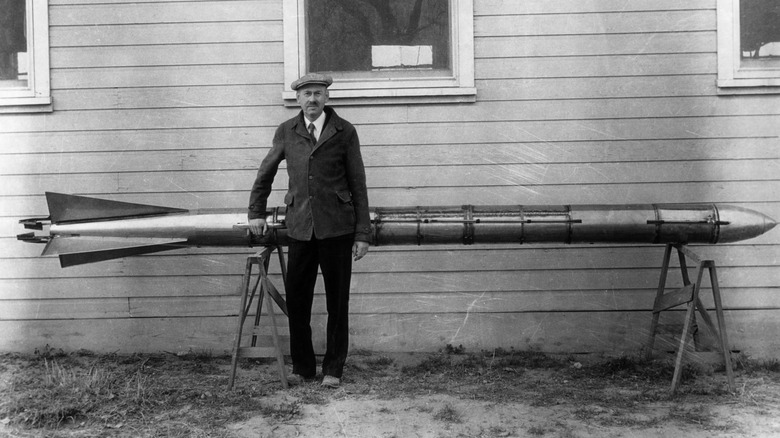Roswell, New Mexico Should Be Famous For More Than Just Aliens
The prospect of aliens existing — like those depicted in films and comics — has garnered curiosity for many, many years. Case in point: More than 200,000 people a year flock to the International UFO Museum & Research Center in Roswell, New Mexico. While the city became synonymous with aliens after the UFO incident of 1947 and has leaned into that with themed paraphernalia and attractions, it has such a cool and overlooked history with rocket pioneer Robert Hutchings Goddard.
Goddard was an American professor, physicist, and inventor who is credited as the father of modern rocketry. With funding for research from the Smithsonian Institution (which also published his theories on rocket propulsion and flight) and the Daniel Guggenheim Foundation, his first successful flight of a liquid-propelled rocket occurred in 1926. Just three years later, he tested the first rocket carrying a scientific barometer, camera, and payload. At the time, though, he was experimenting in Massachusetts and needed more room for launching his rockets safely.
That's why Goddard moved to Roswell in 1930 with a small team of assistants. Together, they built different kinds of rockets that were fueled with high-speed pumps, used vanes as guidance tools, and implemented gyro controls for stabilization. In 1935, they launched the first liquid-fuel rocket that moved faster than the speed of sound. During his time in Roswell, he also developed self-cooling rocket motors and other engine components designed for future space exploration. The crowning achievement, though, was a 1.7-mile-high rocket flight.
The impact of Goddard's genius goes beyond space exploration
Robert Goddard's legacy includes 214 patents awarded between 1914 and 1956 — 131 of which were filed after his passing in 1945 — which established the fundamentals of how rockets are made and work. His mathematical calculations introduced the idea of escape velocity, which is the speed necessary to pull away from Earth's gravitational pull, and his work proved that rockets would function beyond the atmosphere. For these contributions to space exploration, NASA founded the Goddard Space Flight Center in 1959 in Maryland.
However, Goddard's research and experiments have also been used to further military efforts, but it wasn't the U.S. military to use them first. Actually, the U.S. government didn't pay much attention to him and didn't find his research useful when he offered it during World War II. That's why he had to close the Roswell facility and go under contract with the Navy to assist with developing jet-assisted seaplane takeoff and variable-thrust liquid-propellant rocket engines. Instead, Germany saw value in the work and used many of his technical details to create the V-2 missiles that they used during the war. Some of the same German engineers actually had a hand in developing modern rocket engines in the United States post-war.
After his death, Goddard's wife continued publishing his papers and filing for his patents. It wasn't until 1959 that Congress recognized his achievements with a gold medal and his role as the "father of space flight."

